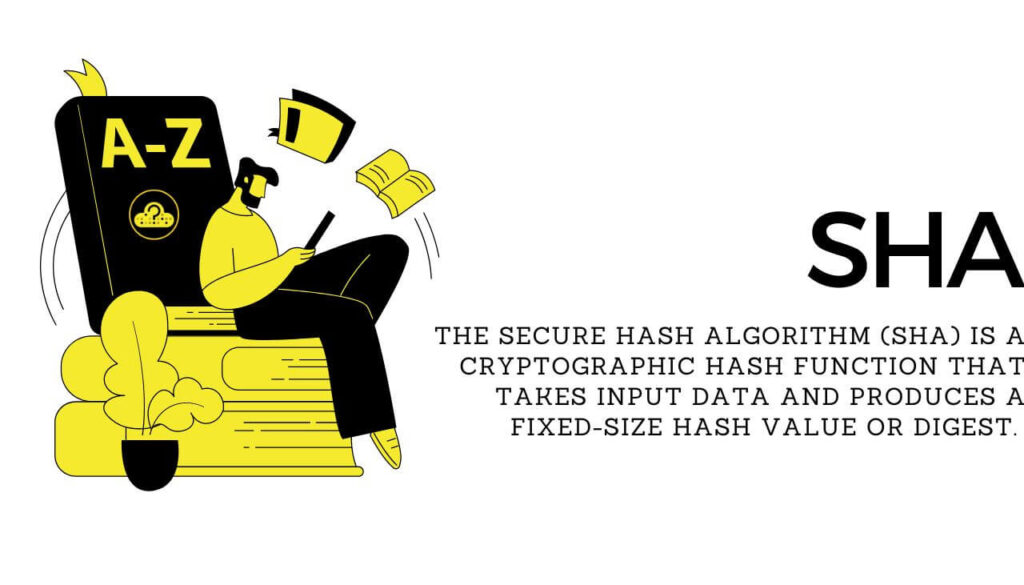What Is SHA?
- Short Definition:
-
The Secure Hash Algorithm (SHA) is a cryptographic hash function that takes input data and produces a fixed-size hash value or digest. It is designed to be a one-way function, meaning it is computationally infeasible to reverse-engineer the original input data from the hash value. It is commonly used in various security applications, including data integrity verification, password storage, and digital signatures.
The term “SHA” refers to a secure hashing algorithm. It is a modified version of MD5 and is utilized for the purpose of hashing data and certificates. Hashing algorithms are designed to transform input data into a condensed format using bitwise operations, modular additions, and compression functions. Unlike encryption, which can be reversed, hashing is a one-way process, meaning that once data is hashed, the resulting hash digest cannot be decrypted, except through exhaustive brute force methods.

- Extended Definition:
- SHA-1. The SHA-1 algorithm was developed in 1995 and produces a 160-bit hash digest. It was widely used for many years but is now considered weak due to vulnerabilities in its collision resistance. As a result, its use is deprecated in most security applications.
- SHA-2. The SHA-2 family consists of SHA-224, SHA-256, SHA-384, and SHA-512. These algorithms, developed in 2001, provide hash digests of different sizes: 224, 256, 384, and 512 bits, respectively. SHA-256, in particular, is widely used and considered secure for most applications.
- SHA-3. SHA-3 is the latest addition to the SHA family, designed as a competition to select a new standard. The selected algorithm, Keccak, became SHA-3 in 2015. It offers hash digests of various sizes, including 224, 256, 384, and 512 bits. SHA-3 is considered secure and provides an alternative option to SHA-2.
The Secure Hash Algorithm (SHA) is a family of cryptographic hash functions developed by the National Security Agency (NSA) in the United States. The primary purpose of SHA is to provide data integrity and security by generating a fixed-size output, known as a hash value or digest, from any given input data. The hash value is unique to the input data, meaning even a slight change in the input will result in a significantly different output.
How Do Secure Hash Algorithms Operate?
When the initial message undergoes SHA-1 hashing, the resulting hash digest is “06b73bd57b3b938786daed820cb9fa4561bf0e8e.” If a second message, similar to the first, is hashed with SHA-1, the hash digest will appear as “66da9f3b8d9d83f34770a14c38276a69433a535b.” This phenomenon is known as the avalanche effect, which holds significance in cryptography. It implies that even the slightest alteration in the input message will entirely transform the output, preventing attackers from comprehending the original content of the hash digest and determining whether the message was tampered with during transmission.
It should also be mentioned that SHAs play a crucial role in detecting modifications to the original message. By comparing the hash digest with the reference value, a user can identify even a single letter change, as the resulting hash digests will be completely dissimilar. Another essential characteristic is their determinism. This means that given knowledge of the hash function employed, any computer or user can reproduce the same hash digest. The deterministic nature of the hash algorithms is one of the reasons why every SSL certificate on the Internet must be hashed using a SHA-2 function.
What Are the Types of SHA Algorithms?
There are several types of Secure Hash Algorithm that have been developed to provide different hash functions with varying hash digest sizes. Here are the commonly recognized SHA algorithms:
How to Choose the Right Type of Secure Hash Algorithm?
The choice of which algorithm to use depends on the specific requirements of the application, such as desired hash digest size and level of security needed. It is generally recommended to use SHA-2 or SHA-3 algorithms for new implementations, while SHA-1 is discouraged due to its vulnerabilities. The transition from SHA-1 to SHA-256 has been encouraged in various industries and standards, such as SSL/TLS certificates, to enhance security.
For more definitions, check out our dedicated Definitions List.
